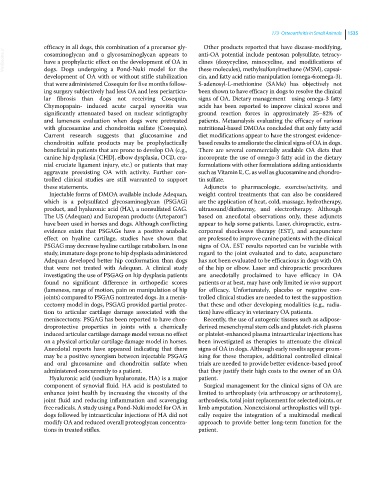Page 1597 - Clinical Small Animal Internal Medicine
P. 1597
173 Osteoarthritis in Small Animals 1535
efficacy in all dogs, this combination of a precursor gly- Other products reported that have disease‐modifying,
VetBooks.ir cosaminoglycan and a glycosaminoglycan appears to anti‐OA potential include pentosan polysulfate, tetracy-
clines (doxycycline, minocycline, and modifications of
have a prophylactic effect on the development of OA in
dogs. Dogs undergoing a Pond‐Nuki model for the
cin, and fatty acid ratio manipulation (omega‐6:omega‐3).
development of OA with or without stifle stabilization these molecules), methylsulfonylmethane (MSM), capsai-
that were administered Cosequin for five months follow- S‐adenosyl‐L‐methionine (SAMe) has objectively not
ing surgery subjectively had less OA and less periarticu- been shown to have efficacy in dogs to resolve the clinical
lar fibrosis than dogs not receiving Cosequin. signs of OA. Dietary management using omega‐3 fatty
Chymopapain‐ induced acute carpal synovitis was acids has been reported to improve clinical scores and
significantly attenuated based on nuclear scintigraphy ground reaction forces in approximately 25–82% of
and lameness evaluation when dogs were pretreated patients. Metaanalysis evaluating the efficacy of various
with glucosamine and chondroitin sulfate (Cosequin). nutritional‐based DMOAs concluded that only fatty acid
Current research suggests that glucosamine and diet modifications appear to have the strongest evidence‐
chondroitin sulfate products may be prophylactically based results to ameliorate the clinical signs of OA in dogs.
beneficial in patients that are prone to develop OA (e.g., There are several commercially available OA diets that
canine hip dysplasia [CHD], elbow dysplasia, OCD, cra- incoroprate the use of omega-3 fatty acid in the dietary
nial cruciate ligament injury, etc.) or patients that may formulations with other formulations adding antioxidants
aggravate preexisting OA with activity. Further con- such as Vitamin E, C, as well as glucosamine and chondro-
trolled clinical studies are still warranted to support tin sulfate.
these statements. Adjuncts to pharmacologic, exercise/activity, and
Injectable forms of DMOA available include Adequan, weight control treatments that can also be considered
which is a polysulfated glycosaminoglycan (PSGAG) are the application of heat, cold, massage, hydrotherapy,
product, and hyaluronic acid (HA), a nonsulfated GAG. ultrasound/diathermy, and electrotherapy. Although
The US (Adequan) and European products (Arteparon®) based on anecdotal observations only, these adjuncts
have been used in horses and dogs. Although conflicting appear to help some patients. Laser, chiropractic, extra-
evidence exists that PSGAGs have a positive anabolic corporeal shockwave therapy (EST), and acupuncture
effect on hyaline cartilage, studies have shown that are professed to improve canine patients with the clinical
PSGAG may decrease hyaline cartilage catabolism. In one signs of OA. EST results reported can be variable with
study, immature dogs prone to hip dysplasia administered regard to the joint evaluated and to date, acupuncture
Adequan developed better hip conformation than dogs has not been evaluated to be efficacious in dogs with OA
that were not treated with Adequan. A clinical study of the hip or elbow. Laser and chiropractic procedures
investigating the use of PSGAG on hip dysplasia patients are anecdotally proclaimed to have efficacy in OA
found no significant difference in orthopedic scores patients or at best, may have only limited in vivo support
(lameness, range of motion, pain on manipulation of hip for efficacy. Unfortunately, placebo or negative con-
joints) compared to PSGAG nontreated dogs. In a menis- trolled clinical studies are needed to test the supposition
cectomy model in dogs, PSGAG provided partial protec- that these and other developing modalities (e.g., radia-
tion to articular cartilage damage associated with the tion) have efficacy in veterinary OA patients.
meniscectomy. PSGAG has been reported to have chon- Recently, the use of autogenic tissues such as adipose‐
droprotective properties in joints with a chemically derived mesenchymal stem cells and platelet‐rich plasma
induced articular cartilage damage model versus no effect or platelet‐enhanced plasma intraarticular injections has
on a physical articular cartilage damage model in horses. been investigated as therapies to attenuate the clinical
Anecdotal reports have appeared indicating that there signs of OA in dogs. Although early results appear prom-
may be a positive synergism between injectable PSGAG ising for these therapies, additional controlled clinical
and oral glucosamine and chondroitin sulfate when trials are needed to provide better evidence‐based proof
administered concurrently to a patient. that they justify their high costs to the owner of an OA
Hyaluronic acid (sodium hyaluronate, HA) is a major patient.
component of synovial fluid. HA acid is postulated to Surgical management for the clinical signs of OA are
enhance joint health by increasing the viscosity of the limited to arthroplasty (via arthroscopy or arthrotomy),
joint fluid and reducing inflammation and scavenging arthrodesis, total joint replacement for selected joints, or
free radicals. A study using a Pond‐Nuki model for OA in limb amputation. Nonexcisional arthroplasties will typi-
dogs followed by intraarticular injections of HA did not cally require the integration of a multimodal medical
modify OA and reduced overall proteoglycan concentra- approach to provide better long‐term function for the
tions in treated stifles. patient.

